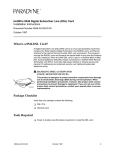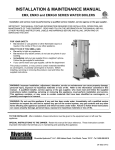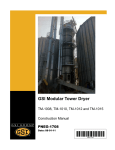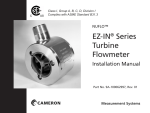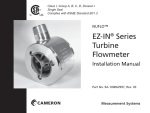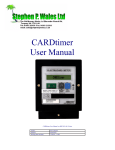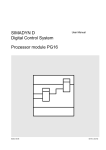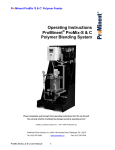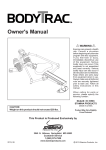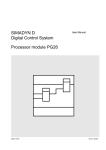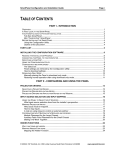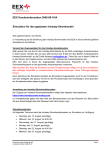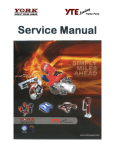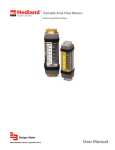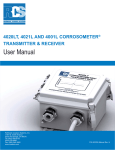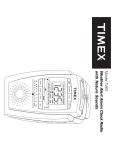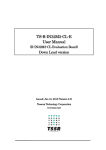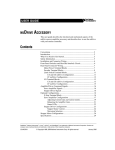Download Barton 7000 Series Turbine Flowmeters User Manual
Transcript
Barton® 7000 Series Turbine Flowmeters 71xx, 72xx, & 73xx for Liquid 74xx for Gas CE marked meters conform to the European Union Pressurized Equipment Directive (PED), 97/23/EC User Manual Part No. 9A-11350, Rev. 01 August 2009 Table of Contents Safety Information............................................................................................. 2 Section 1—Introduction..................................................................................... 3 Barton 7000 Series Flowmeters.................................................................... 3 Specifications—7000 Series Turbine Flowmeters......................................... 3 Electrical Classification.............................................................................. 3 Pressure Boundary Certification................................................................ 4 Measurement Performance........................................................................ 4 Specifications—Standard Pickup Coil ....................................................... 5 CE Markings (for PED flowmeters only)........................................................ 5 Section 2—Installation and Operation............................................................... 7 Unpacking...................................................................................................... 7 Unpacking Procedure................................................................................. 7 Best Practices for Installation........................................................................ 9 Filtration..................................................................................................... 9 Electrical Installation.................................................................................. 9 Flowmeter Position..................................................................................... 9 Flowmeter Location.................................................................................. 10 Bolt Size/Torque Requirements................................................................ 12 System Pressure ..................................................................................... 13 Installation Procedure.................................................................................. 13 Section 3—Maintenance................................................................................. 17 Routine Maintenance Checklist................................................................... 17 Parts Replacement...................................................................................... 18 Repair Kits................................................................................................... 18 Disassembly/Assembly................................................................................ 21 Model 7100 Fractional-Sized Flowmeters................................................ 21 Model 7100/7300 Flowmeters (1 in. and larger)...................................... 22 Model 7200/7400 Flowmeters.................................................................. 24 Electrical Pickup Coil Check........................................................................ 25 Troubleshooting........................................................................................... 25 Section 4—Dimensional Drawings.................................................................. 29 Safety Information Before installing this instrument, become familiar with the installation instructions in Section 2. ! WARNING: This symbol identifies information about practices or circumstances that can lead to personal injury or death, property damage, or economic loss. CAUTION: Indicates actions or procedures which if not performed correctly may lead to personal injury or incorrect function of the instrument or connected equipment. IMPORTANT: Indicates actions or procedures which may affect instrument operation or may lead to an instrument response that is not planned. 2 Model 7000 Series Turbine Flowmeter Section 1 Section 1—Introduction Barton 7000 Series Flowmeters Barton 7000 Series flowmeters are specially designed to accommodate a broad range of precise fluid measurement applications. They can accept larger flow rates with lower pressure drops than other meters in their class, and feature a self-flushing design for longer sustained accuracy. Their high-frequency digital output is ideal for interfacing with digital readout equipment. The 7000 Series' symmetrical bi-directional design supports reverse flow applications, without reducing accuracy or flow capacity. All meters are shipped with a pickup coil. Each meter assembly includes two locknuts, two flow straightener tube assemblies, a center shaft, two diffusers, and a rotor, and is factory-calibrated with water. Bearing type varies with models: Models 7100 and 7300 feature wear-resistant tungsten carbide sleeve bearings and thrust washers. Models 7200 and 7400 feature self-lubricating, precision stainless steel ball bearings. The Model 7400 features bearings with dry lubricant impregnated ball separators. During operation, fluid passes over the diffuser section and is accelerated onto a multi-blade hydro-dynamically balanced turbine rotor. The rotor speed is proportional to the volumetric flow rate. As the rotor turns, a reluctance type pickup coil (mounted on the meter) senses the passage of each blade tip and generates a sine wave output with a frequency that is directly proportional to the flow rate. The rotor is the only moving part of the Barton turbine flowmeter. The small lightweight rotor hubs ensure fast response to process flow changes. The rotor is hydro-dynamically balanced during operation, eliminating the need for mechanical thrust leveling. This low-friction design improves metering linearity and reduces wear and maintenance. The pickup coil is inserted into a conduit adapter that is welded to the outside of the turbine body. The boss is explosion-proof/flameproof with 3/4" male NPT electrical threads. The pickup coil can be removed for troubleshooting without depressurizing the meter or stopping fluid flow. Specifications—7000 Series Turbine Flowmeters Electrical Classification • Explosion-proof/Flameproof CSA listed Class I, Division 1, Group B,C,D; Class II, E,F,G; Class III, Enclosure 4 waterproof to NEC (USA) and CEC (Canadian) standards, including single seal certification to ANSI 12.27.0-1. 3 Section 1 • Model 7000 Series Turbine Flowmeter Intrinsically Safe/Non-incendive approved to various standards as governed by the certification of the readout device and the specific entity parameters of the pickup coils listed with that device. Pressure Boundary Certification • Conformity to PED 97/23/EC Measurement Performance Refer to Cameron product literature (technical data sheets) for full descriptions and capabilities. • • • • Linearity (Models 7100, 7200, 7300)* -- ±1.0% for 1/4-in. and 3/8-in. sizes -- ±0.5% for 1/2-in., 5/8-in., and 3/4-in. sizes -- ±0.25% for 1-in. and larger sizes Linearity (Model 7400)* -- ±1.0% for single K-factor Custody transfer approved by Measurement Canada Temperature Range -- Model 7100, 7300: -160°F to 850°F (-107°C to 454°C) -- Model 7200, 7400: -425°F to 570°F (-254°C to 299°C) For temperature and pressure derating information, see Section 2, Table 2.3 and 2.4, page 15, and Table 2-5, page 16. The temperature range required for any given application is dependent on the bearing design, electronics/electrical selections and meter housing materials. Contact Cameron for help in selecting a meter and components that are appropriate for high-temperature or low-temperature applications. Meter Pickup Coil(s) A variable reluctance generating pickup coil contains a permanent magnet and a wire winding. In Model 7100, 7200 and 7400 flowmeters, the rotor blade of the turbine meter is made of a ferritic stainless steel such as grade 430. The movement of the rotor blade in proximity to the magnetic field of the coil tip produces an AC type voltage pulse within the coil winding. In Model 7300, the ferritic bars imbedded in the rotor shroud interact with the pickup coil. Because the bars on the shroud outnumber the blades on a standard rotor, the 7300 flowmeter provides more pulses per unit volume (resolution). This feature is valuable when proving large-capacity meters with a small-volume prover. Shielded wire cable conveys the output of the pickup coil to compatible electronic instruments to indicate flow rate, record, and/or totalize the volumetric flow. Since the coil itself does not require electrical power, the standard pickup coil incorporates connection pins that mate to a quick connector. 4 Model 7000 Series Turbine Flowmeter Section 1 The pickup coil can drive a variety of instruments including flow rate indicators, totalizers, preamplifiers or flow computers/RTUs. Preamplifiers are used to transmit the coil signal over extended distances to remote-mounted instruments. The meter may be factory-fitted with multiple coils for redundancy, indication of flow direction or pulse train verification. The pickup coil type and magnetic strength vary with application requirements. For coil replacement, refer to the part number etched on the coil body. Specifications—Standard Pickup Coil Temperature Range������������������������ -450°F to +450°F (-268°C to +232°C) (not including meter and mating connectors) DC Resistance������������������������������� 1200 ohms (nominal) Inductance�������������������������������������� 450 mh (nominal) Dielectric Strength Rating��������������� 500 VAC rms minimum Insulation Resistance Rating���������� 100 megaohms @100V Number of Pins������������������������������� 2 Connector��������������������������������������� MIL-C-5015 (mates with MS31 06-10SL-4S) Dimensions������������������������������������� See Section 5 - ODD Drawing Other models may be suitable, depending on the application. See the Spare Parts List, page 18, for information on alternate models. CE Markings (for PED flowmeters only) Barton 7000 flowmeters that are built to conform to the European Union Pressurized Equipment Directive (PED) are marked with the following information: • • • • • • • • • • Part number Serial number Maximum working pressure Minimum working pressure Minimum temperature (°F, °C) Nominal diameter Material Manufacturer's name and address CE mark* Notified body identification number *1-in. flowmeters are not CE-marked. The basis for PED conformance is Sound Engineering Practice (SEP). 5 Section 1 6 Model 7000 Series Turbine Flowmeter Model 7000 Series Turbine Flowmeter Section 2 Section 2—Installation and Operation Unpacking All Barton flowmeters are tested and inspected during manufacture. However, the instrument should be inspected at time of unpacking to detect any damage that may have occurred during shipment. Unpacking Procedure 1. For applications requiring special cleaning/precautions, a polyethylene bag is used to protect the instrument from contamination. This bag should be removed only in an extremely clean environment. 2. Unpack the meter and verify the accuracy of the information listed on the packing slip (proper model number, serial number, calibration data, etc.). 3. Remove the threaded protectors or flange covers from the meter housing. 4. For meters up to 3-inch size, place the meter in a horizontal position and blow (lung pressure should be sufficient) into the inlet port. Place larger meters in a horizontal position and turn the rotor by hand or with a wooden dowel. In either instance, the rotor should turn freely with no evidence of roughness or binding in the rotation. 5. Visually inspect the meter inside and outside (without disassembling the meter). Report any visible damage to Cameron immediately. 6. Replace the thread protectors and flange covers, then place the meter back inside the polyethylene bag. Note: Meters may be stored indefinitely in the polyethylene bag. CAUTION: Clean all upstream lines before installing the meter. Foreign debris will damage or collect on the rotor. Do not blow out liquid lines with compressed air or gas once the meter has been installed. Do not slug liquid meters with fluid. Carefully fill the line after installing the meter. After startup, keep the meter full of liquid. Do not expose Model 7400 gas flowmeters to liquids. They will damage the meter. If the end connection leaks at the time of installation, remove pressure before attempting to tighten the seal. Use appropriate bolts and hardware per ANSI B16.5 and, if applicable, per NACE MRO175 / ISO 15156. Where process temperatures are high, the turbine meter surfaces may be hazardous to touch. Exercise caution when operating or servicing. 7 Section 2 ! Model 7000 Series Turbine Flowmeter WARNING: The customer is responsible for ensuring chemical compatibility between the flowmeter and any fluids being metered. Never exceed the maximum recommended pressure and temperature limits. Never exceed the maximum recommended flow rate for the meter. For installations where the pressure could exceed the rated maximum safe working pressure of the turbine meter housing or flanges, the piping system must include protective measures to prevent over pressure, in accordance with applicable local and national piping code. The turbine meter is not designed for high static or dynamic loads at the end connections. The piping system must be designed with adequate supports to minimize the loads at the turbine meter, in accordance with applicable local and national piping code. The turbine meter may be under pressure. Ensure that the piping system is completely depressurized before removing the meter for maintenance or inspection. 8 Model 7000 Series Turbine Flowmeter Section 2 Best Practices for Installation Before installing a Barton turbine flowmeter, read the following best practices in their entirety. Filtration All meters should be installed with upstream filtration to isolate the meter from damage from foreign objects in the piping system. See the Barton 7000 Series product data sheet for recommended filtration size. Cameron offers start-up screens as an optional accessory to prevent damage from foreign objects. Avoid the use of Teflon® tape on body threads. Strands can enter the flowstream and collect on the rotor, causing measurement error. All meters should be isolated from gas or liquid “slugs” which can cause damage by over-speed and water hammer. Electrical Installation Consider the process operating temperature when selecting the type and location of electric fitting and instrument components. Heat conducted and radiated from the turbine can damage wiring, connectors, electrical housing and circuit boards. The meter can be installed so that the pickup coil is in any plane. Avoid orienting the pickup coil in a 12 o'clock position in applications with elevated temperatures. Where possible, minimize the length of signal transmission cables from the pickup. The signal from the turbine is a low-voltage AC sine wave that can be as low as 30mV peak-to-peak. Electrical noise on the wires will cause false counts on the readout instruments. Direct-mounting a totalizer or preamplifier is preferred. If this is not possible, ensure that the signal cable is not near power cables, other signal cables, or routed where electrical noise may interfere with signal transmission. Follow common wiring installation practices, using quality cable (twisted pair, shielded with ground wire). Flowmeter Position Barton turbine flowmeters are calibrated in a horizontal position. Therefore, the best correlation of calibration occurs when the meter is operated in this plane. However, the meter will operate satisfactorily in any position. 9 Section 2 Model 7000 Series Turbine Flowmeter Flowmeter Location See Figure 2.1 for reference. Location of the flowmeter to obtain optimum accuracy is dependent upon several factors. • • • • Relative to the System—When the flow is expected to be intermittent, the meter should not be mounted at a low point in the piping system since solids can settle on, or congeal around the rotor. These solids can cause the rotor to freeze or otherwise be damaged. Tolerance to Mechanical Vibration—The turbine meter is constructed to withstand rugged service. However, meter life can be increased by locating the meter so as to protect it from the direct shock or mechanical vibration. Tolerance to Electrical Interference—To obtain the best electrical signal output from the meter, locate the meter at a distance from sources of electrical interference. A preamplifier is recommended for use on all installations to reduce the effect of undesired noise. Where practical, install the meter upstream of control valves and pressure regulators. Where necessary, the meter should be at least 100 pipe diameters from the valves. Model 7400 flowmeters feature a pressure tap on the body opposite the rotor. For compliance with international measurement standards, any pressure sensor used for computation of corrected volume should sense pressure from this tap. 10 Model 7000 Series Turbine Flowmeter Section 2 Figure 2.1—Flowmeter piping arrangements 11 Section 2 Model 7000 Series Turbine Flowmeter Bolt Size/Torque Requirements Bolt sizes vary with meter size and flange rating. See Table 2.4 for bolt specifications recommended in ASME B16.5-2003. Torque requirement vary with meter size, threads, and fitting/nut material. See Table 2.2 for recommended torque values. Table 2.1—Recommended Bolt Sizes Meter Size (in.) Flange Rating 150 LB 300 LB 600 LB 900 LB 1500 LB 2500 LB 1/2 2-1/4x1/2 2-1/2x1/2 3x1/2 4-1/4x3/4 4-1/4x3/4 — 3/4 2-1/2x1/2 3x5/8 3-1/2x5/8 4-1/2x3/4 4-1/2x3/4 — 5-1/4x7/8 1 2-1/2x1/2 3x5/8 3-1/2x5/8 5x7/8 5x7/8 1-1/4 2-3/4x1/2 3-1/4x5/8 3-3/4x5/8 5x7/8 5x7/8 5-3/4x1 1-1/2 2-3/4x1/2 3-1/2x3/4 4-1/4x3/4 5-1/2x1 5-1/2x1 6-1/2x1-1/8 2 3-1/4x5/8 3-1/2x5/8 4-1/4x5/8 5-3/4x7/8 5-3/4x7/8 6-3/4x1 2-1/2 3-1/2x5/8 4x3/4 4-3/4x3/4 6-1/4x1 6-1/4x1 7-1/2x1-1/8 3 3-1/2x5/8 4-1/4x3/4 5x3/4 5-3/4x7/8 7x1-1/8 8-1/2x1-1/4 4 3-1/2x5/8 4-1/2x3/4 5-3/4x7/8 6-3/4x1-1/8 7-3/4x1-1/4 9-3/4x1-1/2 5 3-3/4x3/4 4-3/4x3/4 6-1/2x1 7-1/2x1-1/4 9-3/4x1-1/2 11-1/2x1-3/4 6 4x3/4 4-3/4x3/4 6-3/4x1 7-1/2x1-1/8 10-1/4x1-3/8 13-1/2x2 8 4-1/4x3/4 5-1/2x7/8 7-1/2x1-1/8 8-3/4x1-3/8 11-1/2x1-5/8 15x2 10 4-1/2x7/8 6-1/4x1 8-1/2x1-1/4 9-1/4x1-3/8 13-1/4x1-7/8 19x2-1/2 12 4-3/4x7/8 6-3/4x1-1/8 8-3/4x1-1/4 10x1-3/8 14-3/4x2 21x2-3/4 Table 2.2—Torque Values Torque* inch-lbs (N-m) Dash No. O.D. Tubing (inches) Fittings Threads (Unified Threads Class 3A may be used) Aluminum & Other Non-Ferrous Alloy Fittings & Nuts Steel & Other Ferrous Alloy Fittings & Nuts 8 1/2 3/4-16 NF-3 150-200 (17-22.6) 220-300 (24.8-33.9) 10 5/8 7/8-14 NF-3 205-275 (23.2-31) 300-410 (33.9-46.3) 12 3/4 1-1/16-12 N-3 300-400 (33.9-45.2) 450-600 (50.8-67.8) 16 1 1-5/16-12 N-3 450-600 (50.8-67.8) 675-900 (76.3-101.7) 20 1-1/4 1-5/8-12 N-3 540-720 (61-81.3) 825-1100 (93.2-124.3) 24 1-1/2 1-7/8-12 N-3 680-900 (76.8-101.7) 1010-1350 (114-152.3) Notes: Completely dry nuts should be torqued to the high value given. When nuts are lubricated, they should be torqued to the lower value given. * The applicable torque is determined on the basis of the nut and related fitting regardless of the material that the fitting passes through. 12 Model 7000 Series Turbine Flowmeter Section 2 System Pressure The maximum and minimum system pressures must be considered when installing the turbine meter into the system. • Minimum Meter Pressure—To obtain proper response, a back pressure should be applied to the meter. This back pressure should be at least twice the pressure drop of the meter at maximum flow (all meters). For liquid meters, the back pressure should be twice the pressure drop of the meter at maximum flow, plus twice the fluid vapor pressure. Minimum Pressure at the Meter = (2 x Net Pressure Drop at Maximum Flow) + (2x Vapor Pressure of Fluid) Some piping arrangements cause this amount of back pressure on the meter due to downstream restriction, valves, etc. If additional back pressure is needed, a downstream orifice or valve can be added in accordance with the piping arrangements shown in Figure 2.1, page 11. Installation Procedure Prior to installing the turbine meter into the system, perform the following: 1. Install a “spool piece” and allow sufficient flow through the system to completely flush any foreign material from the system. If foreign material is expected in the flow the fluid should be filtered. This is especially important for ball bearing meters. 2. Remove gas "slugs" from liquid meter flow lines and liquid "slugs" from gas meter flow lines. 3. If the meter is used in a cryogenic application, (available by special order only; limited to model 7200 meters), install a bypass for cooling the piping without passing fluid through the meter (Figure 2.2). This prevents gasification of the cryogenic fluid and ensures all flow passing through the meter is liquid. Figure 2.2—Flowmeter bypass 4. If liquid meters are to be "proved" for accuracy in-situ using a portable prover, install prover taps per API standards. 5. Install a straight section of pipe on either side of the meter. This pipe must be the same nominal pipe size as the meter with a length of at least 10 pipe diameters upstream and 5 pipe diameters downstream. (For example, a flowmeter with a 2-in. nominal diameter requires a 2-in. pipe. 13 Section 2 6. 7. 8. 9. Model 7000 Series Turbine Flowmeter The section of straight pipe upstream must be 20 in.; the section downstream must be 10 in.) Do not install throttling valves within 100 pipe diameters upstream of the flowmeter. Install a flow straightener upstream and downstream of the meter. The applicable filter should be selected according to ISA Standard RP31.1. All fluids to be used with a Model 7200 turbine meter should be free of particles larger than approximately 10 microns. Align the meter bore with the pipe, ensuring that the direction of flow corresponds with the direction of the arrow engraved on the meter body. All Barton turbine flowmeters have “IN” and “OUT” stamped into the housings to identify the direction of flow in which the meter was calibrated. Insert bolts and apply torque for a leak-proof seal. See Tables 2.1 and 2.2, page 11, for bolt size and torque requirements. Install the magnetic pickup as follows. a. Screw the magnetic pickup clockwise into the conduit adapter until finger-tight. Then rotate the pickup counter-clockwise one quarter turn. Do not tighten with pliers. b. Turn the jam nut clockwise until the pickup is secure. A ¾-in. 12-point deep thin wall socket wrench (Part No. 9A-100013146) is required. c. Attach the signal cable connector to the pickup and turn the swivel nut until the connection is snug. Do not over-tighten. CAUTION: The meter pressure rating has been determined using standard methods and stress allowable values without specific consideration for corrosion (neither internal nor external) or fatigue. The piping system designer should appropriately derate any meter where these considerations are significant issues. IMPORTANT: Any marked maximum working pressure (MWP) rating refers to the meter room temperature pressure rating. For operation at other temperatures, see the pressure derating information in Tables 2.3 and 2.4, page 15, and Table 2.5, page 16. 14 Model 7000 Series Turbine Flowmeter Section 2 Table 2.3—Pressure Ratings (PSI) Flange Class Type 316 SST 7000 Series Turbine Meters with ASME B16.5 Flanges -20°F (-29°C) 100°F (38°C) 200°F (93°C) 300°F (149°C) 400°F (204°C) 500°F (260°C) 600°F (316°C) 650°F (343°C) 700°F (371°C) 750°F (399°C) CL 150 275 275 235 215 195 170 140 125 110 95 CL 300 720 720 620 560 515 480 450 440 435 425 CL 400 960 960 825 745 685 635 600 590 580 570 CL 600 1440 1440 1240 1120 1025 955 900 885 870 855 CL 900 2160 2160 1860 1680 1540 1435 1355 1325 1305 1280 CL 1500 3600 3600 3095 2795 2570 2390 2255 2210 2170 2135 CL 2500 6000 6000 5160 4660 4280 3980 3760 3680 3620 3560 Size Type 316 SST 7000 Series Turbine Meters with NPT/BSP Threads -20°F (-29°C) 100°F (38°C) 200°F (93°C) 300°F (149°C) 400°F (204°C) 500°F (260°C) 600°F (316°C) 650°F (343°C) 700°F (371°C) 750°F (399°C) 1" * 4400 4400 3791 3417 3136 2926 2762 2715 2645 2621 1-1/4" 4000 4000 3447 3106 2851 2660 2511 2468 2404 2383 1-1/2" 3200 3200 2757 2485 2281 2128 2009 1974 1923 1906 2" 2650 2650 2284 2058 1889 1762 1663 1635 1593 1579 * 1-in. flowmeters are not CE marked. The basis for PED conformance is Sound Engineering Practice (SEP). Table 2.4—Pressure Ratings (MPa) Flange Class Type 316 SST 7000 Series Turbine Meters with ASME B16.5 Flanges -29°C 38°C 50°C 100°C 150°C 200°C 250°C 300°C 325°C 350°C CL 150 1.9 1.9 1.8 1.6 1.5 1.4 1.2 1.0 0.93 0.84 CL 300 5.0 5.0 4.8 4.3 3.9 3.6 3.3 3.2 3.1 3.0 CL 400 6.6 6.6 6.4 5.6 5.1 4.8 4.5 4.2 4.1 4.0 CL 600 9.9 9.9 9.6 8.4 7.7 7.1 6.7 6.3 6.2 6.1 CL 900 15.0 15.0 14.0 13.0 12.0 11.0 10.0 9.5 9.3 9.1 CL 1500 25.0 25.0 24.0 21.0 19.0 18.0 17.0 16.0 15.0 15.0 CL 2500 Size 41.4 41.4 40.1 35.2 32.1 29.7 27.8 26.4 25.7 25.3 Type 316 SST 7000 Series Turbine Meters with NPT/BSP Threads -29°C 38°C 93°C 149°C 204°C 260°C 316°C 343°C 371°C 399°C 1" * 30.3 30.3 26.1 23.6 21.6 20.2 19.0 18.7 18.2 18.1 1-1/4" 27.6 27.6 23.8 21.4 19.7 18.3 17.3 17.0 16.6 16.4 1-1/2" 22.1 22.1 19.0 17.1 15.7 14.7 13.9 13.6 13.3 13.1 2" 18.3 18.3 15.8 14.2 13.0 12.2 11.5 11.3 11.0 10.9 * 1-in. flowmeters are not CE marked. The basis for PED conformance is Sound Engineering Practice (SEP). 15 Section 2 Model 7000 Series Turbine Flowmeter Table 2.5—Pressure Ratings (Bar) Flange Class Type 316 SST 7000 Series Turbine Meters with ASME B16.5 Flanges -29°C 38°C 50°C 100°C 150°C 200°C 250°C 300°C 325°C CL 150 19.0 19.0 18.4 16.2 14.8 13.7 12.1 10.2 9.3 8.4 CL 300 49.6 49.6 48.1 42.8 38.5 35.7 33.4 31.6 30.9 30.3 CL 400 66.2 66.2 64.2 56.3 51.3 47.6 44.5 42.2 41.2 40.4 CL 600 99.3 99.3 96.2 84.4 77.0 71.3 66.8 63.2 61.8 60.7 CL 900 148.9 148.9 144.3 126.6 115.5 107.0 100.1 94.9 92.7 91.0 CL 1500 248.2 248.2 240.6 211.0 192.5 178.3 166.9 158.1 154.4 151.6 CL 2500 413.7 413.7 400.9 351.6 320.8 297.2 278.1 263.5 257.4 252.7 Size 350°C Type 316 SST 7000 Series Turbine Meters with NPT/BSP Threads -29°C 38°C 93°C 149°C 204°C 260°C 316°C 343°C 371°C 399°C 1" * 303.4 303.4 261.4 235.6 216.2 201.7 190.4 187.2 182.4 180.7 1-1/4" 275.8 275.8 237.7 214.1 196.6 183.4 173.1 170.2 165.7 164.3 1-1/2" 220.6 220.6 190.1 171.3 157.3 146.7 138.5 136.1 132.6 131.4 2" 182.7 182.7 157.5 141.9 130.2 121.5 114.7 112.7 109.8 108.9 * 1-in. flowmeters are not CE marked. The basis for PED conformance is Sound Engineering Practice (SEP). 16 Model 7000 Series Turbine Flowmeter Section 3 Section 3—Maintenance Barton 7000 Series flowmeters have a proven history of providing long cycle periods between maintenance intervals. It is recommended the meters be inspected every 3 to 5 years unless measurement anomalies occur. Many installations are suitable for much longer maintenance cycles. Routine Maintenance Checklist Perform the following steps as part of your routine maintenance. 1. Before removing internal components from the meter, check the rotor to determine if it turns freely. 2. Disassemble the meter and check for evidence of erosion or other mechanical damage to the interior of the meter body or internal components. a. The rotor blade edges should be defined and not excessively rounded. b. The rotor should be uniform and symmetrical. c. Models 7100 and 7300 tungsten carbide bushings and bearings should be free of radial play. d. Model 7400 tungsten carbide bushings and bearings are dry lubricated and may emit a uniform sound and may not feel perfectly smooth when rotated. This is normal. e. Model 7400 and Model 7200 bearings should be free of axial and radial play. 3. In a vented area, clean each part thoroughly in di-chlorethylene or any similar cleaning solvent before reassembling the meter. 17 Section 3 Model 7000 Series Turbine Flowmeter Parts Replacement See Table 3.1 for a list of recommended spare parts. ! WARNING: Use only spare parts identified in this manual. Cameron bears no legal responsibility for the performance of a product that has been serviced or repaired with parts that are not authorized by Cameron. Table 3.1—Electrical Spare Parts Pickup Coils Meter Size 1/4-in. through 3/4-in. 1-in. through 12-in. Temperature Rating Part Number -450°F to +450°F (-268°C to +232°C) 9A-2112-0001A-01 -58°F to +347°F (-50°C to +175°C) 9A-2113-0001A-01* -450°F to 850°F (-268°C to +454°C) 9A-2114-0001A-01** -450°F to +450°F (-268°C to +232°C) 9A-2112-0001A-02 -58°F to +347°F (-50°C to +175°C) 9A-2113-0001A-02* -450°F to 850°F (-268°C to +454°C) 9A-2114-0001A-02** Connectors and Cables - Partial Listing Connector Only (MS 3106-10SL-4S or equivalent - rubber boot included) 9A-8001-1009B Connector w/12" wires 9A-0818-1020B Connector w/12" wires (required in some intrinsicallly safe installations) 9A-0818-1050B Adapter/Reducer, 1" MNPT x 3/4" FNPT 9A-0159-1008T * Suitable for Intrinsically Safe/ATEX approved meters ** Suitable only for flowmeters that have been approved by Cameron for use at extreme temperatures. Contact Cameron for details. Repair Kits Should an internal component of a Barton turbine flowmeter require replacement, replace all internals with a repair kit. See Tables 3.2 through 3.4, page 19, and Table 3.5, page 20, for a complete list of repair kits. Repair kits are factory-calibrated with water using eight data points and two repeat points. They are calibrated with the meter in which they are to be installed. Therefore, they should be purchased with the meter to prevent downtime. If the repair kit has not been calibrated and on-site proving (calibration) cannot be performed, return the meter and the repair kit to the factory for calibration. 18 Model 7000 Series Turbine Flowmeter Section 3 Table 3.2—Model 7100 Kits Model Meter Size Part Number 7184 1/2" 9A-7084-9001-BA-01 7185 5/8" 9A-7085-9001-BA-01 7186 3/4" 9A-7086-9001-BA-01 7101 1" 9A-7001-9001-BA-01 7145 1-1/4" 9A-7045-9001-BA-01 7146 1-1/2" 9A-7046-9001-BA-01 7102 2" 9A-7002-9001-BA-01 7103 3" 9A-7003-9001-BA-01 7104 4" 9A-7004-9001-BA-01 7106 6" 9A-7006-9001-BA-01 7108 8" 9A-7008-9001-BA-01 7110 10" 9A-7010-9001-BA-01 7112 12" 9A-7012-9001-BA-01 Table 3.3—Model 7200 Kits Model Meter Size Part Number 7282 1/4" 9A-7082-9001-BA-02 7283 3/8" 9A-7083-9001-BA-02 7284 1/2" 9A-7084-9001-BA-02 7285 5/8" 9A-7085-9001-BA-02 7286 3/4" 9A-7086-9001-BA-02 7201 1" 9A-7001-9001-BA-02 7245 1-1/4" 9A-7045-9001-BA-02 7246 1-1/2" 9A-7046-9001-BA-02 7202 2" 9A-7002-9001-BA-02 7203 3" 9A-7003-9001-BA-02 7204 4" 9A-7004-9001-BA-02 7206 6" 9A-7006-9001-BA-02 Table 3.4—Model 7300 Kits Model Meter Size Part Number 7102 2" 9A-7002-9001-BA-01 7103 3" 9A-7003-9001-BA-01 7304 4" 9A-7004-9001-BA-03 7306 6" 9A-7006-9001-BA-03 7308 8" 9A-7008-9001-BA-03 7310 10" 9A-7010-9001-BA-03 7312 12" 9A-7012-9001-BA-03 19 Section 3 Model 7000 Series Turbine Flowmeter Table 3.5—Model 7400 Kits 20 Model Meter Size Part Number 7486 3/4" 9A-7086-9001-BA-04 9A-7050-9001-BA-04 7450 1" 7475 1" 9A-7075-9001-BA-04 7401 1" 9A-7001-9001-BA-04 7445 1-1/4" 9A-7045-9001-BA-04 7446 1-1/2" 9A-7046-9001-BA-04 7402 2" 9A-7002-9001-BA-04 7403 3" 9A-7003-9001-BA-04 7404 4" 9A-7004-9001-BA-04 7406 6" 9A-7006-9001-BA-04 7408 8" 9A-7008-9001-BA-04 7410 10" 9A-7010-9001-BA-04 7412 12" 9A-7012-9001-BA-04 Model 7000 Series Turbine Flowmeter Section 3 Disassembly/Assembly ! WARNING: Before disassembling or assembling a Barton turbine flowmeter, read all safety cautions and warnings on pages 7 and 8. A special tool can be fabricated for disassembling Barton 7000 Series flowmeters. See Figure 3.1 for a fabrication diagram. Figure 3.1—Flowmeter disassembly tool Model 7100 Fractional-Sized Flowmeters IMPORTANT: Field repairs for 1/4 in. and 3/8 in. Model 7100 flowmeters are not recommended. These meters must be returned to the factory for disassembly and repair. FLOW * PART OF BUSHING ASSEMBLY Figure 3.2—Model 7100 fractional-sized flowmeters 21 Section 3 Model 7000 Series Turbine Flowmeter Model 7100/7300 Flowmeters (1 in. and larger) 1. Remove downstream locknut (see Figure 3.3, page 23). 2. Insert hook end of special disassembly tool into downstream flow straightener tube and engage hook on inside edge of tube. 3. Slide impact hammer along tube, striking the anvil. Use light force and repeat until tube is ejected from meter housing. 4. Remove downstream diffuser, wear washers, journal bearing, rotor bushing, and rotor. The bushing is press-fitted into the rotor and both are removed simultaneously from the housing. 5. From the upstream end of the housing, remove the center shaft, wear washer, upstream diffuser, upstream flow straightener, tube assembly, and upstream locknut as a unit. Disassemble as required. To reassemble the meter, perform the following steps: 1. Assemble the center shaft, wear washer, upstream diffuser, upstream flow straightener, tube assembly, and upstream locknut. 2. Assemble the downstream diffuser, wear washers, journal bearing, and rotor bushing/rotor. IMPORTANT: All rotors are marked (with a line or dot) on the upstream end of the rotor. To maintain calibration, ensure the marked end of the meter is installed on the upstream end of the meter. 3. Insert the downstream flow straightener tube assembly into the meter housing and position on the center shaft. Align the two straightener assemblies as close as possible to maintain calibrated configuration. 4. Attach and tighten the downstream locknut. 22 * PART OF BUSHING ASSEMBLY ON MODEL 7300 METERS Figure 3.3—Model 7100 and Model 7300 meter disassembly/assembly sequence FLOW * Model 7000 Series Turbine Flowmeter Section 3 23 Section 3 Model 7000 Series Turbine Flowmeter Model 7200/7400 Flowmeters 1. Remove the downstream locknut (see Figure 3.4). 2. Insert the hook end of the special disassembly tool into the downstream flow straightener tube and engage the hook on the inside edge of tube. 3. Slide the impact hammer along tube, striking the anvil. Use light force and repeat until the tube is ejected from the meter housing. 4. Remove the downstream diffuser, spacer, ball bearings, adapter, and rotor. 5. From the upstream end of the housing, remove the center shaft, wear washer, upstream diffuser, upstream flow straightener, tube assembly, and upstream locknut as a unit. Disassemble as required. To assemble the meter, perform the following steps. 1. Assemble the center shaft, wear washer, upstream diffuser, upstream flow straightener, tube assembly, and upstream locknut. 2. Assemble the downstream diffuser, wear washers, journal bearing, and rotor bushing/rotor. IMPORTANT: All rotors are marked (with a line or dot) on the upstream end of the rotor. To maintain calibration, ensure the marked end of the meter is installed on the upstream end of the meter. 3. Insert the downstream flow straightener tube assembly into the meter housing and position on the center shaft. Align the two straightener assemblies as close as possible to maintain calibrated configuration. 4. Attach and tighten the downstream locknut. FLOW * PART OF SHAFT ON MODEL 7200 METERS 3/4 IN. AND SMALLER Figure 3.4—Model 7200 and Model 7400 flowmeter disassembly/assembly sequence 24 Model 7000 Series Turbine Flowmeter Section 3 Electrical Pickup Coil Check Items Needed: Ohmmeter and Oscilloscope 1. With an ohmmeter, measure the resistance between the pickup pins. The resistance should be approximately 1200 ohms. 2. Measure the resistance between each pin and the pickup coil housing. The resistance should be at least 100 megohms. 3. If either of the above readings are not as specified, replace the pickup coil. 4. Connect an oscilloscope to the pickup coil. Check the signal-to-noise ratio by comparing the peak-to-peak voltage while running the meter at the minimum flow rate versus the peak-to-peak voltage at no flow. The ratio shall be in the area of 20:1 or higher. If the signal-to-noise ratio is not as required, examine the immediate area for either radiated or conducted type of electrical interference. Minimize the electrical interference by removing the source of the interference or by reorienting the meter. The most effective method of locating the source of electrical interference is to turn off the power to electrical machinery or electronic devices one item at a time, and observe the change in amplitude of the interference signal. IMPORTANT: A low signal-to-noise ratio can feed deceptive information to the electronic instrumentation of the system. The addition of a preamplifier at the turbine meter will provide improved signal-to-noise ratio. Troubleshooting Turbine meter system malfunctions are usually restricted to two areas: electrical/electronic, or mechanical. When a malfunction or an apparent malfunction occurs, the electrical/electronic systems should first be thoroughly checked in accordance with the manufacturer's recommended procedures, prior to checking the turbine meter. Only when the source of the malfunction cannot be found in the electrical or electronic systems should the turbine meter be inspected. IMPORTANT: Before performing any troubleshooting, refer to information, instructions, and Warning/Caution notices in Sections 2 and 3. 25 Section 3 Model 7000 Series Turbine Flowmeter Fluid Delivery Greater Than Indicated on Totalizer Note: Verify that the proper "K" factor value is entered in the electronic readout device. Possible Cause Corrective Action Foreign material collected on rotor or bearings. When foreign material collects on or in the bearings or if material wraps around the rotor (such as strands of teflon tape), the angular velocity of the rotor will be reduced. This allows more fluid to pass through the meter than the pulse train indicates. Remove the meter from the line and visually inspect internally. If foreign material is present, remove the material. If no foreign material is found, disassemble the meter, clean the parts, and reassemble and reinstall the meter in the line. If cleaning does not eliminate the problem, check for bearing wear, as described below. Excessive bearing wear. Excessive bearing wear will lower the angular velocity of the rotor and rotation may stop completely. Effect is the same as with foreign material. Replace meter internals with a repair kit. See part numbers, starting on page 19. Fluid Delivery Less Than Indicated on Totalizer Note: Verify that the proper "K" factor value is entered in electronic readout device. Possible Cause Corrective Action Ground loop in electrical circuit. See manufacturer's manual. Gasification of liquid in meter. Cameron recommends that a back pressure be applied to the system. This back pressure should be twice the magnitude of the net pressure loss through the meter plus twice the magnitude of the vapor pressure of the liquid being metered. If this back pressure is not maintained, gasification can occur within the meter, causing an over-spin of the rotor. This will indicate a greater than actual delivery and cause damage to the bearings. Provide a back pressure at the meter by using accepted design means and practices. Entrained gas or bubbles in metered liquid. If the fluid has a significant amount of entrained gas or gas bubbles which are released in the reservoir, over registration can occur. Turbine meters measure the actual volume of the liquid. If a unit volume is expanded by entrained gas or bubbles, this expansion will be registered. Gas bubbles may cavitate the rotor and produce effects similar to those caused by gasification of liquid in the meter. Eliminate entrained gas or bubbles by use of an air eliminator or other acceptable method. 26 Model 7000 Series Turbine Flowmeter Section 3 Possible Cause Corrective Action Excessive electrical noise. Unsheilded cable used in close proximity to an electrical motor can cause electrical noise, which can be misinterpreted by the totalizer as volume. Ensure that the cable used to connect the pickup to the totalizer is properly shielded and grounded. Erratic Output Possible Cause Corrective Action Sensitivity, noise, or foreign material disturbing the fluid profile through the meter. Verify proper sensitivity setting of electronic readout instrument; remove intermittent noise signals; remove meter from the line and inspect flow straighteners for foreign material; inspect the rotor for broken blades; check meter run for proper length of upstream and downstream straight pipe installation (see page 11). No Output Possible Cause Corrective Action Wrong or poor electrical cable connections. Check connections, correct as necessary. No flow. Verify flow through pipe. Defective pickup coil. Remove and check the pickup coil for continuity between the pins, replace if defective. Frozen rotor. Remove meter from line and check rotor for free-spin. If necessary, replace rotor. Inspect bearings and bearing surfaces for foreign material. Inspect wear washers, spacers, diffuser, and rotor hub. If no wear is found, clean and reassemble. If wear is found, replace parts and recalibrate. 27 Section 3 28 Model 7000 Series Turbine Flowmeter Model 7000 Series Turbine Flowmeter Section 4 Section 4—Dimensional Drawings Figure 4.1 shows a typical installation of a Barton 7000 Series flowmeter. Refer to Tables 4.1 through 4.6, pages 30 to 35, for actual dimensions. Values are presented in inches unless otherwise stated. A ± 1/16 in. C MODEL 818 PREAMPLIFIER (OPTIONAL) STAND-OFF TUBE ELECTRICAL CONNECTOR PICKUP COIL COIL BOSS (3/4 IN. MNPT) B DIA. Figure 4.1—Barton 7000 series flowmeter dimensions 29 Section 4 Model 7000 Series Turbine Flowmeter Table 4.1—150# ANSI Dimensions Line Size (in.) 30 No. of Holes Dia. of Holes in. (mm) Dia. of B.C. in. (mm) 2-1/2 (63.5) 4 5/8 (15.9) 2-3/8 (60.3) 3-1/2 (88.9) 2-1/2 (63.5) 4 5/8 (15.9) 2-3/8 (60.3) 5 (127) 3-1/2 (88.9) 2-1/2 (63.5) 4 5/8 (15.9) 2-3/8 (60.3) 5/8 5-1/2 (139.7) 3-7/8 (98.4) 2-3/4 (69.9) 4 5/8 (15.9) 2-3/4 (69.9) 3/4 5-1/2 (139.7) 3-7/8 (98.4) 2-3/4 (69.9) 4 5/8 (15.9) 2-3/4 (69.9) 1 5-1/2 (139.7) 4-1/4 (108) 2-3/4 (69.9) 4 5/8 (15.9) 3-1/8 (79.4) 1-1/4 6 (152.4) 4-5/8 (117.5) 3 (76.2) 4 5/8 (15.9) 3-1/2 (88.9) 1-1/2 6 (152.4) 5 (127) 3 (76.2) 4 5/8 (15.9) 3-7/8 (98.4) 2 6-1/2 (165.1) 6 (152.4) 3-1/4 (82.6) 4 3/4 (19.1) 4-3/4 (120.7) 2-1/2 7 (177.8) 7 (177.8) 3-1/2 (88.9) 4 3/4 (19.1) 5-1/2 (139.7) 3 10 (254) 7-1/2 (190.5) 5 (127) 4 3/4 (19.1) 6 (152.4) 4 12 (304.8) 9 (228.6) 6 (152.4) 8 3/4 (19.1) 7-1/2 (190.5) 5 14 (355.6) 10 (254) 7 (177.8) 8 7/8 (22.2) 8-1/2 (215.9) 6 14 (355.6) 11 (279.4) 7 (177.8) 8 7/8 (22.2) 9-1/2 (241.3) 8 16 (406.4) 13-1/2 (342.9) 8 (203.2) 8 7/8 (22.2) 11-3/4 (298.5) 10 20 (508) 16 (406.4) 10 (254) 12 1 (25.4) 14-1/4 (362.0) 12 24 (609.6) 19 (482.6) 12 (304.8) 12 1 (25.4) 17 (431.8) A in. (mm) B in. (mm) C in. (mm) 1/4 5 (127) 3-1/2 (88.9) 3/8 5 (127) 1/2 Model 7000 Series Turbine Flowmeter Section 4 Table 4.2—300# ANSI Dimensions Line Size (in.) No. Holes Dia. of Holes in. (mm) Dia. of B.C. in. (mm) 2-1/2 (63.5) 4 5/8 (15.9) 2-5/8 (66.7) 3-3/4 (95.3) 2-1/2 (63.5) 4 5/8 (15.9) 2-5/8 (66.7) 5 (127) 3-3/4 (95.3) 2-1/2 (63.5) 4 5/8 (15.9) 2-5/8 (66.7) 5/8 5-1/2 (139.7) 4-5/8 (117.5) 2-3/4 (69.9) 4 5/8 (15.9) 3-1/4 (82.6) 3/4 5-1/2 (139.7) 4-5/8 (117.5) 2-3/4 (69.9) 4 5/8 (15.9) 3-1/4 (82.6) 1 5-1/2 (139.7) 4-7/8 (123.8) 2-3/4 (69.9) 4 3/4 (19.1) 3-1/2 (88.9) 1-1/4 6 (152.4) 5-1/4 (133.4) 3 (76.2) 4 3/4 (19.1) 3-7/8 (98.4) 1-1/2 6 (152.4) 6-1/8 (155.6) 3 (76.2) 4 7/8 (22.2) 4-1/2 (114.3) 2 6-1/2 (165.1) 6-1/2 165.1) 3-1/4 (82.6) 8 3/4 (19.1) 5 (127) 2-1/2 7 (177.8) 7-1/2 (190.5) 3-1/2 (88.9) 8 7/8 (22.2) 5-7/8 (149.2) 3 10 (254) 8-1/4 (209.6) 5 (127) 8 7/8 (22.2) 6-5/8 (168.3) 4 12 (304.8) 10 (254) 6 (152.4) 8 7/8 (22.2) 7-7/8 (200.0) 5 14 (355.6) 11 (279.4) 7 (177.8) 8 7/8 (22.2) 9-1/4 (235.0) 6 14 (355.6) 12-1/2 (317.5) 7 (177.8) 12 7/8 (22.2) 10-5/8 (269.9) 8 16 (406.4) 15 (381) 8 (203.2) 12 1 (25.4) 13 (330.2) 10 20 (508) 17-1/2 (444.5) 10 (254) 16 1-1/8 (28.6) 15-1/4 (387.4) 12 24 (609.6) 20-1/2 (520.7) 12 (304.8) 16 1-1/4 (31.8) 17-3/4 (450.8) A in. (mm) B in. (mm) C in. (mm) 1/4 5 (127) 3-3/4 (95.3) 3/8 5 (127) 1/2 31 Section 4 Model 7000 Series Turbine Flowmeter Table 4.3—600# ANSI Dimensions Line Size (in.) 32 No. Holes Dia. of Holes in. (mm) Dia. of B.C. in. (mm) 2-1/2 (63.5) 4 5/8 (15.9) 2-5/8 (66.7) 3-3/4 (95.3) 2-1/2 (63.5) 4 5/8 (15.9) 2-5/8 (66.7) 5 (127) 3-3/4 (95.3) 2-1/2 (63.5) 4 5/8 (15.9) 2-5/8 (66.7) 5/8 5-1/2 (139.7) 4-5/8 (117.5) 2-3/4 (69.9) 4 3/4 (19.1) 3-1/4 (82.6) 3/4 5-1/2 (139.7) 4-5/8 (117.5) 2-3/4 (69.9) 4 3/4 (19.1) 3-1/4 (82.6) 1 5-1/2 (139.7) 4-7/8 (123.8) 2-3/4 (69.9) 4 3/4 (19.1) 3-1/2 (88.9) 1-1/4 6 (152.4) 5-1/4 (133.4) 3 (76.2) 4 3/4 (19.1) 3-7/8 (98.4) 1-1/2 6 (152.4) 6-1/8 (155.6) 3 (76.2) 4 7/8 (22.2) 4-1/2 (114.3) 2 6-1/2 (165.1) 6-1/2 (165.1) 3-1/4 (82.6) 8 3/4 (19.1) 5 (127.0) 2-1/2 7 (177.8) 7-1/2 (190.5) 3-1/2 (88.9) 8 7/8 (22.2) 5-7/8 (149.2) 3 10 (254) 8-1/4 (209.6) 5 (127) 8 7/8 (22.2) 6-5/8 (168.3) 4 12 (304.8) 10-3/4 (273.1) 6 (152.4) 8 1 (25.4) 8-1/2 (215.9) 5 14 (355.6) 13 (330.2) 7 (177.8) 8 1-1/8 (28.6) 10-1/2 (266.7) 6 14 (355.6) 14 (355.6) 7 (177.8) 12 1-1/8 (28.6) 11-1/2 (292.1) 8 16 (406.4) 16-1/2 (419.1) 8 (203.2) 12 1-1/4 (31.8) 13-3/4 (349.2) 10 20 (508) 20 (508) 10 (254) 16 1-3/8 (34.9) 17 431.8) 12 24 (609.6) 22 (558.8) 12 (304.8) 20 1-3/8 (34.9) 19-1/4 (489.0) A in. (mm) B in. (mm) C in. (mm) 1/4 5 (127) 3-3/4 (95.3) 3/8 5 (127) 1/2 Model 7000 Series Turbine Flowmeter Section 4 Table 4.4—900# ANSI Dimensions Line Size (in.) No. Holes Dia. of Holes in. (mm) Dia. of B.C. in. (mm) 3-1/2 (88.9) 4 7/8 (22.2) 3-1/4 (82.6) 4-3/4 (120.7) 3-1/2 (88.9) 4 7/8 (22.2) 3-1/4 (82.6) 7 (177.8) 4-3/4 (120.7) 3-1/2 (88.9) 4 7/8 (22.2) 3-1/4 (82.6) 5/8 7 (177.8) 5-1/8 (130.2) 3-1/2 (88.9) 4 7/8 (22.2) 3-1/2 (88.9) 3/4 7 (177.8) 5-1/8 (130.2) 3-1/2 (88.9) 4 7/8 (22.2) 3-1/2 (88.9) 1 8 (203.2) 5-7/8 (149.2) 4 (101.6) 4 1 (25.4) 4 (101.6) 1-1/4 8 (203.2) 6-1/4 (158.8) 4 (101.6) 4 1 (25.4) 4-3/8 (111.1) 1-1/2 9 (228.6) 7 (177.8) 4-1/2 (114.3) 4 1-1/8 (28.6) 4-7/8 (123.8) 2 9 (228.6) 8-1/2 (215.9) 4-1/2 (114.3) 8 1 (25.4) 6-1/2 (165.1) 2-1/2 10 (254) 9-5/8 (244.5) 5 (127) 8 1-1/8 (28.6) 7-1/2 (190.5) 3 10 (254) 9-1/2 (241.3) 5 (127) 8 1 (25.4) 7-1/2 (190.5) 4 12 (304.8) 11-1/2 (292.1) 6 (152.4) 8 1-1/4 (31.8) 9-1/4 (235.0) 5 14 (355.6) 13-3/4 (349.3) 7 (177.8) 8 1-3/8 (34.9) 11 (279.4) 6 14 (355.6) 15 (38.1) 7 (177.8) 12 1-1/4 (31.8) 12-1/2 (317.5) 8 16 (406.4) 18-1/2 (469.9) 8 (203.2) 12 1-1/2 (38.1) 15-1/2 (393.7) 10 20 (508) 21-1/2 (546.1) 10 (254) 16 1-1/2 (38.1) 18-1/2 (469.9) 12 24 (609.6) 24 (609.6) 12 (304.8) 20 1-1/2 (38.1) 21 (533.4) A in. (mm) B in. (mm) C in. (mm) 1/4 7 (177.8) 4-3/4 (120.7) 3/8 7 (177.8) 1/2 33 Section 4 Model 7000 Series Turbine Flowmeter Table 4.5—1500# ANSI Dimensions Line Size (in.) 34 No. Holes Dia. of Holes in. (mm) Dia. of B.C. in. (mm) 3-1/2 (88.9) 4 7/8 (22.2) 3-1/4 (82.6) 4-3/4 (120.7) 3-1/2 (88.9) 4 7/8 (22.2) 3-1/4 (82.6) 7 (177.8) 4-3/4 (120.7) 3-1/2 (88.9) 4 7/8 (22.2) 3-1/4 (82.6) 5/8 7 (177.8) 5-1/8 (130.2) 3-1/2 (88.9) 4 7/8 (22.2) 3-1/2 (88.9) 3/4 7 (177.8) 5-1/8 (130.2) 3-1/2 (88.9) 4 7/8 (22.2) 3-1/2 (88.9) 1 8 (203.2) 5-7/8 (149.2) 4 (101.6) 4 1 (25.4) 4 (101.6) 1-1/4 8 (203.2) 6-1/4 (158.8) 4 (101.6) 4 1 (25.4) 4-3/8 (111.1) 1-1/2 9 (228.6) 7 (177.8) 4-1/2 (114.3) 4 1-1/8 (28.6) 4-7/8 (123.8) 2 9 (228.6) 8-1/2 (215.9) 4-1/2 (114.3) 8 1 (25.4) 6-1/2 (165.1) 2-1/2 10 (254) 9-5/8 (244.5) 5 (127) 8 1-1/8 (28.6) 7-1/2 (190.5) 3 10 (254) 10-1/2 (266.7) 5 (127) 8 1-1/4 (31.8) 8 (203.2) 4 12 (304.8) 12-1/4 (311.2) 6 (152.4) 8 1-3/8 (34.9) 3-1/2 (88.9) 5 14 (355.6) 14-3/4 (374.7) 7 (177.8) 8 1-5/8 (41.3) 11-1/2 (292.1) 6 14 (355.6) 15-1/2 (393.7) 7 (177.8) 12 1-1/2 (38.1) 12-1/2 (317.5) 8 16 (406.4) 19 (482.6) 8 (203.2) 12 1-3/4 (44.5) 15-1/2 (393.7) 10 20 (508) 23 (584.2) 10 (254) 12 2 (50.8) 19 (482.6) 12 24 (609.6) 26-1/2 (673.1) 12 (304.8) 16 2-1/8 (54.0) 22-1/2 (571.5) A in. (mm) B in. (mm) C in. (mm) 1/4 7 (177.8) 4-3/4 (120.7) 3/8 7 (177.8) 1/2 Model 7000 Series Turbine Flowmeter Section 4 Table 4.6—2500# ANSI Dimensions Line Size (in.) No. Holes Dia. of Holes in. (mm) Dia. of B.C. in. (mm) 4 (101.6) 4 1 (25.4) 4-1/4 (108.0) 7-1/4 (184.1) 4 (101.6) 4 1-1/8 (28.6) 5-1/8 (130.2) 9 (228.6) 8 (203.2) 4-1/2 (114.3) 4 1-1/4 (31.8) 5-3/4 (146.0) 2 9 (228.6) 9-1/4 (235.0) 4-1/2 (114.3) 8 1-1/8 (28.6) 6-3/4 (171.4) 2-1/2 10 (254) 10-1/2 (266.7) 5 8 1-1/4 (31.8) 7-3/4 (196.8) 3 11 (279.4) 12 (304.8) 5-1/2 (139.7) 8 1-3/8 (34.9) 9 (228.6) 4 12 (304.8) 14 (355.6) 6 (152.4) 8 1-5/8 (41.3) 10-3/4 (273.0) A in. (mm) B in. (mm) C in. (mm) 1 8 (203.2) 6-1/4 (158.8) 1-1/4 8 (203.2) 1-1/2 35 Product Warranty A. Warranty Cameron International Corporation (“Cameron”) warrants that at the time of shipment, the products manufactured by Cameron and sold hereunder will be free from defects in material and workmanship, and will conform to the specifications furnished by or approved by Cameron. B. Warranty Adjustment 1. If any defect within this warranty appears, Buyer shall notify Cameron immediately 2. Cameron agrees to repair or furnish a replacement for, but not install, any product which within one (1) year from the date of shipment by Cameron shall, upon test and examination by Cameron, prove defective within the above warranty. 3. No product will be accepted for return or replacement without the written authorization of Cameron. Upon such authorization, and in accordance with instructions by Cameron, the product will be returned shipping charges prepaid by Buyer. Replacements made under this warranty will be shipped prepaid. C. Exclusions from Warranty 1. THE FOREGOING WARRANTY IS IN LIEU OF AND EXCLUDES ALL OTHER EXPRESSED OR IMPLIED WARRANTIES OF MERCHANTABILITY, OR FITNESS FOR A PARTICULAR PURPOSE, OR OTHERWISE. 2. Components manufactured by any supplier other than Cameron shall bear only the warranty made by the manufacturer of that product, and Cameron assumes no responsibility for the performance or reliability of the unit as a whole. 3. “In no event shall Cameron be liable for indirect, incidental, or consequential damages nor shall the liability of Cameron arising in connection with any products sold hereunder (whether such liability arises from a claim based on contract, warranty, tort, or otherwise) exceed the actual amount paid by Buyer to Cameron for the products delivered hereunder.” 4. The warranty does not extend to any product manufactured by Cameron which has been subjected to misuse, neglect, accident, improper installation or to use in violation of instructions furnished by Cameron. 5. The warranty does not extend to or apply to any unit which has been repaired or altered at any place other than at Cameron’s factory or service locations by persons not expressly approved by Cameron. Product Brand Barton® is a registered trademark of Cameron International Corporation (“Cameron”).




































